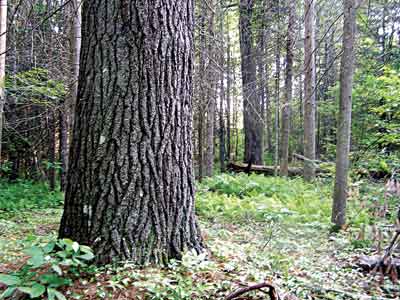 |
| When forests are left to grow, they continue to sequester carbon. English photo |
By Peter Hagerty
When my wife and I moved to Maine in 1974, I went into the woods logging with a team of horses named Barney and Nick. Since that first winter we have always had big horses on our farm. In the early days everyone cut trees with chainsaws and hauled out the logs and pulp with crawler tractors, skidders, horses and, on occasion, oxen. We all knew each other, were friends and helped one another when needed. Many of us worked on paper company land, followed the instructions of the company forester and slept soundly every night.
I have never met a logger who wanted to hurt the forest intentionally. Loggers hunt deer under the trees, fish along forest lakes and appreciate the fragile ecosystem that exists on the forest floor. Today our small town of Porter is home to some of the largest logging companies in the state. Our son and daughter’s friends and classmates now drive enormous grapple machines that haul entire trees – along with their attached branches and leaves – out of the woods without ever starting a chainsaw. Some work 12 hours a day, six days a week.
But a perfect storm is forming on the horizon that MOFGA’s Low Impact Forestry (LIF) Program is working to address. In an attempt to reduce their carbon footprint, energy companies from Britain and many other EU countries have relied on wood biomass for fuel, according to Duncan Brack (“The Impacts of the Demand for Woody Biomass for Power and Heat on Climate and Forests,” Chatham House, Feb. 23, 2017). These countries are running out of trees and recently have begun sourcing wood chips and pellets from our southern states. They are now looking to the Maine forest and its wood industry for more fuel.
Trees sequester carbon but not if they are cut down for biomass. According to Michael LePage, “Burning wood produces more carbon dioxide, methane and nitrogen dioxide per unit of energy than coal,” and logging causes forest soils to release carbon for the next decade or two. Transporting and processing of wood also involve potentially considerable emissions, says LePage. On the other hand, when forests are left to grow, they continue to sequester carbon – even mature forests. “Older trees absorb much more carbon than younger trees, so despite the death of some trees, mature forests are still a carbon sink overall,” says LePage. (“The EU’s renewable energy policy is making global warming worse,” New Scientist, Feb. 23, 2017; “Woody Biomass for Power and Heat: Impacts on the Global Climate,” by Duncan Brack, Chatham House, Feb. 23, 2017)
The LIF Project and MOFGA are looking into developing criteria to identify certain Maine forests that agree to prioritize carbon sequestration ahead of short-term financial incentives as they manage their woodlands. Is the Maine forest more valuable as a carbon sink or as an exporter of wood chips for fuel? And how might jobs be created in these innovative experiments? We are just now defining the questions, and we look forward to your input. For questions or comments please contact us at [email protected]. Thank you for your consideration.
To learn more, we recommend “Beyond the Beauty Strip” and “Low Impact Forestry – Forestry as if the Future Mattered” by Mitch Lansky, an LIF founder from Wytopitlock, Maine.
About the author: Peter Hagerty is a founding member of MOFGA’s Low Impact Forestry Program. He and his wife, Marty Tracy, own Peace Fleece in Porter, Maine.
About this column: This column covers the work of the Low Impact Forestry Program at MOFGA – a group of loggers, foresters, landowners, farmers and interested persons educating about, practicing and advocating for ecologically based and economically sound forest practices. We practice and endorse forestry that seeks to reduce the known harmful impacts of logging, and promote the social and ecological benefits. The LIF Program hosts workshops year-round covering all sorts of forestry-related topics, from logging with draft animals to home firewood production. The LIF Program also participates in collaborative logging projects that explore creative forest management and contracts that benefit both landowner and logger. Click here for more information.
